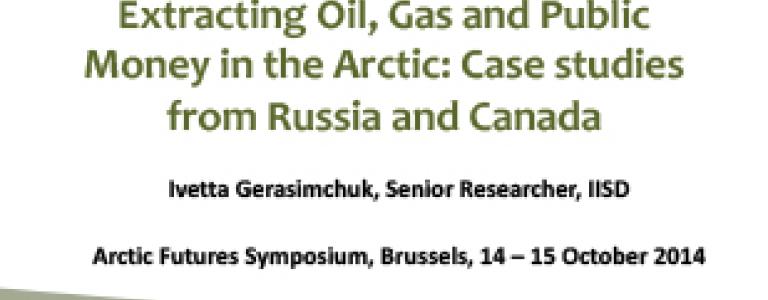Extracting Oil, Gas and Public Money in the Arctic: Case studies from Russia and Canada
The International Institute for Sustainable Development (IISD) presented on “Extracting Oil, Gas and Public Money in the Arctic: Case studies from Russia and Canada” at the “Arctic Futures” conference in Brussels on October 15, 2014. The video of this presentation is available here.
What are the costs of Arctic oil, gas and gold, and who is paying them? Several studies have attempted to give a range of breakeven prices for extractives in the Arctic, but the extent of government support to exploration and development in the Arctic has been hard to define and compare between countries. IISD’s first-of-its-kind studies quantifying federal and some regional subsidies to oil and gas in Canada and Russia have provoked a lot of debate in both countries, which the research team have addressed through broader research approaches and modelling in its new case studies on individual Arctic projects: the Yamal LNG and Prirazlomnoye hydrocarbon developments in Russia and the Meadowbank gold mine in Canada. The case studies inform a discussion of social costs and benefits of the projects receiving government support in the Arctic, including at the community level. This work has created the basis for IISD’s frameworks for increasing transparency of such extractive projects, and ways forward towards more sustainable natural resource policies in the Arctic.
You might also be interested in
Arctic Sea Ice Loss Enhances the Oceanic Contribution to Climate Change
Since the mid-1990s, there has been a marked decrease in the sea ice extent (SIE) in the Arctic Ocean. After reaching an absolute minimum in September 2012, the seasonal variations in the SIE have settled at a new level, which is almost one-quarter lower than the average climatic norm of 1979–2022. Increased melting and accelerated ice export from marginal seas ensure an increase in the open water area, which affects the lower atmosphere and the surface layer of the ocean. Scientists are cautiously predicting a transition to a seasonally ice-free Arctic Ocean as early as the middle of this century, which is about 50 years earlier than was predicted just a few years ago. Such predictions are based on the fact that the decrease in sea ice extent and ice thinning that occurred at the beginning of this century, initially caused by an increase in air temperature, triggered an increase in the thermal and dynamic contribution of the ocean to the further reduction in the ice cover. This paper reviews published evidence of such changes and discusses possible mechanisms behind the observed regional anomalies of the Arctic Sea ice cover parameters in the last decade.
A Warming Arctic is a Warning for the World
To protect the Arctic, stronger and broader local, national, and international measures to reduce greenhouse gas emissions must be implemented.
